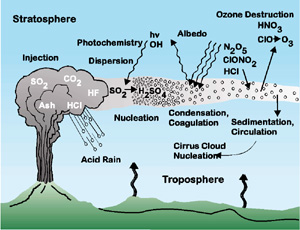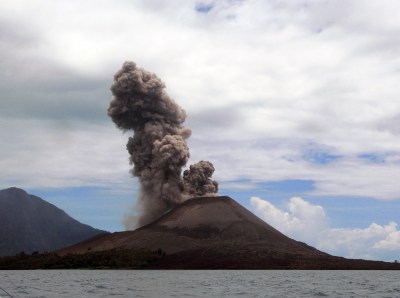EXPLORE: Plate Movement & Earth's Spheres (BrainPop)
| Site: | Mountain Heights Academy OER |
| Course: | Earth Science Q2 |
| Book: | EXPLORE: Plate Movement & Earth's Spheres (BrainPop) |
| Printed by: | Guest user |
| Date: | Thursday, 24 July 2025, 9:06 PM |
Description
.
1. READ: Volcanoes & Mountains

2. READ: Volcanoes & Earth's Spheres

Volcanic eruptions can have a tremendous effect on Earth's atmosphere, affecting both short term and long term climate patterns, influencing the atmosphere and hydrosphere and affecting the biosphere.
The principle gases that are emitted during a volcanic eruption include: water vapor, carbon dioxide, carbon monoxide, sulfur dioxide, hydrogen sulfide, hydrogen chloride, and hydrogen fluoride. A large number of minor and trace gasses are also found in volcanic emissions, for example: hydrogen, carbon monoxide, nitrogen oxides, and volatile metal chlorides. Volcanic gases are harmful to most types of vegetation and can cause damage to the respiratory system of animals. For example, exposure to carbon monoxide can result in suffocation or death, depending on the length of exposure.
Of these gases, carbon dioxide and water vapor are greenhouse gases, and can contribute to global warming by trapping longwave radiation (infrared radiation, or heat) at the Earth's surface and lower atmosphere. Sulfur and nitrogen oxides can mix with the water vapor in the atmosphere and produce acid rain (which harms plants and water ecosystems). Some of these gases also contribute to the destruction of our ozone layer and cause tropospheric pollution (pollution in the lowest level of the atmosphere, which includes the air you breathe). Gases, dust, and ash from a volcanic eruption can also contribute to global cooling. If the eruption cloud is big enough to reach the stratosphere, it can produce a widespread cooling effect. Additionally, sulfate particles in the atmosphere reflect radiation from the sun, therefore preventing it from reaching Earth's surface. The exact climate impacts produced by a volcano is dependent upon how large the the eruption is, and what the global wind patterns are like.
Additionally, the dust and ash from a volcanic eruption can cause condensation nuclei to build in the atmosphere. Condensation nuclei are pieces of dust or ash around which water droplets collect. This forms clouds and can produce precipitation. Heavy rains triggered in this way can cause lahars (mud flows) and debris avalanches, which affect people and ecosystems living in the vicinity of a volcano. The largest impacts to the climate, biosphere, and hydrosphere are felt closest to the volcano.
Source: http://pubs.usgs.gov/of/1997/of97-262/of97-262.html
3. READ: Volcanoes & Climate

Volcanoes can have a very dramatic effect on the climate. First, we'll talk about how volcanoes affect climate in the short-term, influencing the atmosphere, hydrosphere, and biosphere of the Earth. The immediate results can be devastating.
In the U.S. one of the most recent examples was the St. Helens eruption. The catastrophic eruption on May 18, 1980, was preceded by 2 months of intense activity that included more than 10,000 earthquakes, hundreds of small steam-blast explosions, and the outward growth of the volcano's entire north flank by more than 80 meters. A magnitude 5.1 earthquake struck beneath the volcano at 8:32am on May 18, setting in motion the devastating eruption.
Within seconds of the earthquake, the volcano's bulging north flank slid away in the largest landslide in recorded history, triggering a destructive, lethal blast of hot gas, steam, and rock debris that swept across the landscape as fast as 1,100 kilometers per hour. Temperatures within the blast reached as high as 300 degrees Celsius. Snow and ice on the volcano melted, forming torrents of water and rock debris that swept down river valleys leading from the volcano. Within minutes, a massive plume of ash thrust 19 kilometers into the sky, where the prevailing wind carried about 490 tons of ash across 57,000 square kilometers of the Western United States.
Even though temperatures within the blast reached such high temperatures, the haze produced by the dust, ash, and smoke from the eruption blocked the sunlight and caused global temperatures to drop by 0.1 OC. However, the pattern of warming or cooling from a volcano is not always simple. Climatologists with NASA have found that while volcanic eruptions can cause global cooling effects, they may also trigger seasonal climate warming. Computer models developed by climatologists have found that aerosols emitted during an eruption can absorb heat, and cause warming of the troposphere (lower atmosphere) in the winter. The pattern of cooling or warming also depends upon how much sulfur dioxide is emitted from the volcano. Major eruptions that produced large amounts of sulfur oxides (the eruption of Mt. Pinatubo in 1991, for example) contributed to significant global cooling, whereas eruptions that emitted only a small amount of sulfur dioxide to the atmosphere did not significantly lower global temperatures.
Volcanoes can also have long term effects on climate and Earth's spheres. Volcanic debris can break down fertile soil, making it difficult for plants and crops to grow. Endangered animals may be pushed to extinction, which causes disruption to the ecosystem and a loss of biodiversity.
One of the most well-known eruptions was the volcano Krakatoa in 1883. Krakatoa is located in the Pacific Ocean. The eruption was so powerful that its effects were felt across the world. Dust and particles caused copper-colored sunsets over much of the world for two years. Sulfur dioxide spewed out by the volcano caused the average temperature on Earth to drop by at least a degree. While one degree doesn't sound like much, that change is enough to disrupt sensitive ecosystems.
Global cooling related to major volcanic eruptions typically lasts for one to two years after an eruption occurs. Over an even longer period of time, volcanic activity slowly releases carbon dioxide from rocks in the Earth's mantle and crust. Despite the small contribution of such volcanic carbon emissions, it does affect the overall distribution of carbon dioxide and leads to global warming over long periods of time.
Sources
- http://pubs.usgs.gov/gip/volcus/ustext.html (public domain)
- http://eob.gsfc.nasa.gov/Features/Volcano/
- http://pubs.usgs.gov/gip/volc/people.html (public domain)
- http://cnx.org/content/m23176/latest/ (CC BY)
- http://www.dailymail.co.uk/news/worldnews/article-1203028/Will-Krakatoa-rock-world-Last-time-killed-thousands-changed-weather-years-deadlier.html (fair use)
4. VIEW: Mountains & Climate (BrainPop)
Mountains can affect climate. Because mountains have a higher elevation than the surrounding area, temperatures in mountainous areas are cooler than other nearby areas (atmosphere). These areas also receive more precipitation than lower elevations (hydrosphere). The fact that mountains receive and hold moisture is very important for life. In cooler climates, mountains store water as ice and snow until the summer months, when it becomes warmer. As the snow and ice melt, gravity moves the water into surrounding areas through rivers and streams (hydrosphere). These rivers and streams are used by both plants and animals (biosphere). Therefore, mountain climate affects the biosphere, atmosphere, and the hydrosphere.
A mountain's climate can change significantly from its windward side (the side that faces incoming weather) to its leeward side (the side opposite from incoming weather). The windward side receives large amounts of precipitation, while the leeward side receives very little. This affects the types of vegetation and animals (biosphere) that can survive in ecosystems on either side of a mountain. In fact, many of Earth's deserts are found in a mountain's rain shadow. One example is Death Valley.
After you have completed this part of the lesson, you can check the associated box on the main course page to mark it as complete